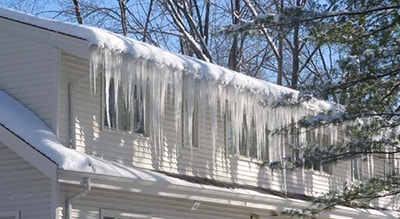A Growing Problem: How to Prevent Ice Dams and Icicles from Damaging Your Home
Icicles hanging from a home’s roof are definitely romanticized in Winter scenes. They’re depicted as beautiful, picturesque, or even romantic, but to any homeowner who’s experienced them, you know the problems icicles or ice dams can be.
How Ice Dams Form
Ice dams are formed when the roof above your home is warmer than the roof near your gutter. Basically, the snow on your roof melts but freezes again before it drips off of your roof. The result? Giant ice dams that wreak havoc on your home.

Ice dams certainly can result in damage to your home’s exterior, like rotting your roof or weighing down your gutters, but what you may not realize is the amount of damage the ice can cause your home’s interior.
Ice dams can result in water seeping into your home’s interior. This may be happening to your home if you’re experiencing water in your attic, water dripping down your walls, or wet insulation. Besides hurting your home’s interior, leaks that go unspotted could damage your home’s artwork, ceilings, electronics, or other valuable belongings.
If unnoticed for a long time, this water can also cause mold to grow in your home. Left to grow, mold can not only damage your home’s health but your family’s health, too.
How to Prevent Ice Dams and Icicles
Homeowners can limit the impact or development of ice dams by focusing on three main areas: improving insulation, improving ventilation, and spotting leaks in their attics. With these improvements, warm air will be kept inside the house, limiting the amount of warm air that escapes and melts snow on the roof.
Improving insulation: Keep your home’s heat where it should be: inside. Improving your insulation will decrease the amount of heat escaping to the roof. A professional from Inspect-It 1st will be able to spot any gaps or missed spots in your attic’ insulation. These gaps allow warm air to escape to your roof, increasing your risk for ice dams. A professional will be able to recommend how to work with your current insulation or if new insulation is needed.
Improving ventilation: Warm air shouldn’t be flowing to your roof, as this will only cause snow to melt and turn into ice dams. A professional will be able to examine your home’s ventilation system and detect is rerouting is needed to prevent ice dams. For instance, vents shouldn’t be channeling air towards your roof.
Look for leaks: Sometimes air rises to your roof through small leaks, which really should be detected before you cover them with insulation. Often, leaks can be found around vents or through cracks in your attic’s floorboards. Sealing these holes with fire-stop sealant can prevent air from escaping to your attic and therefore your roof.
Don’t let ice dams wreck havoc on your home this Winter. With these small improvements, you’ll prevent your home from a host of other damage in 2013.
